Preferences
The preferences section under settings helps you handle certain functions of Zoho Payroll such as providing portal access for employees, managing portal contact information, and their related preferences.
Employee Portal
From this page, you can manage portal access, payroll admin contact information, and send messages to all your employees who have portal access.
Enable or disable portal access for all employees
Toggle the Enable Portal Access option to enable or disable portal access for all employees at one go. This option will help manage overall access for employees but this does not affect the individual portal access preference you’ve configured in employees’ profiles.
To enable and disable portal access:
- Click Settings in the top right corner and select Preferences.
- Toggle the Enable Portal Access option.
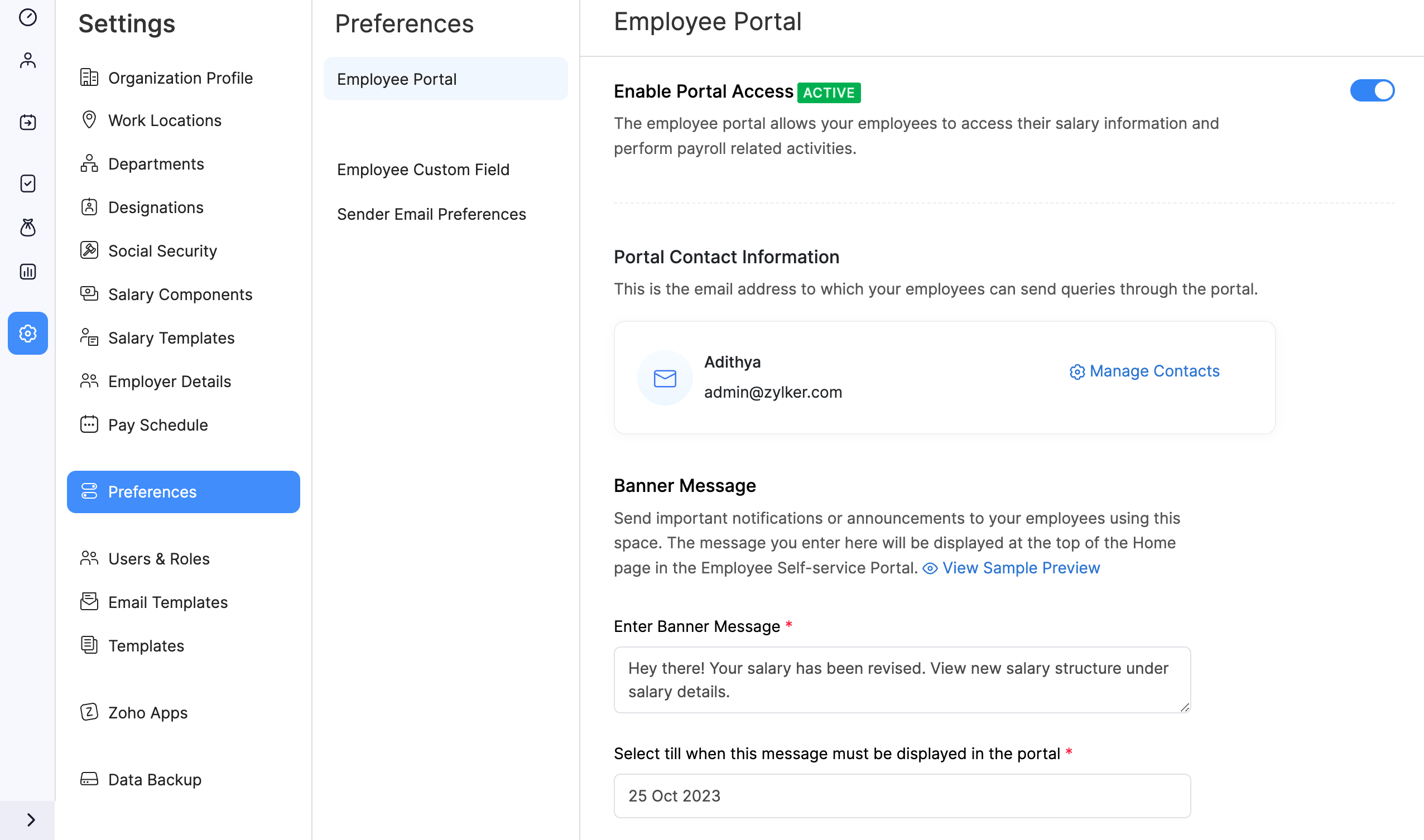
Manage Portal Contact Information
Displaying contact information in the employee self-service portal can be useful for employees to contact someone in case of payroll-related questions or issues.
In Zoho Payroll, you can add multiple contacts. However, only one contact can displayed in the employee self-service portal.
Here’s how you can display the contact information in the Employee Self-Service portal:
- Click Settings in the top right corner and select Preferences.
- Click Employee Portal on the Preferences sidebar.
- Go to Portal Contact Information and click Manage Contacts.

- Click +Add Contact to add a new contact.
- Enter the name and email of the contact.
- Click Save.
- Hover over a contact and click Show in Portal to display the contact in the portal.
Pro-tip: You can click the Edit or Delete icon next to the contact to make any changes or delete the contact.
Display Banner Message in Portal
It is important to ensure that all employees are informed about important updates and changes regarding payroll within the company. One way to effectively communicate these updates is by displaying banner messages in the employee portal.
To display a banner message:
- Click Settings in the top right corner and select Preferences.
- Click Employee Portal on the Preferences sidebar.
- Enter the message and select the date till when this message must be displayed in the portal.
Send important notifications or announcements to your employees using this space. The message you enter here will be displayed at the top of the Home page in the Employee Self-service Portal. You can also view the sample preview.
Your employees will be able to view the banner message in the portal until the date you’ve selected.

Employee Custom Fields
Employee custom fields enable you to include additional information about the employee. Any detail that is not mandated in the payroll but you want to collect can be collected using custom fields. For example, you can record the nominees of employees.
In this document you will learn how to:
- Create a custom field
- Edit a custom field configuration
- Mark a custom field as Inactive
- Delete a custom field
Create a Custom Field
- Go to Settings on the left sidebar and select Preferences.
- Select Employee Custom Field.
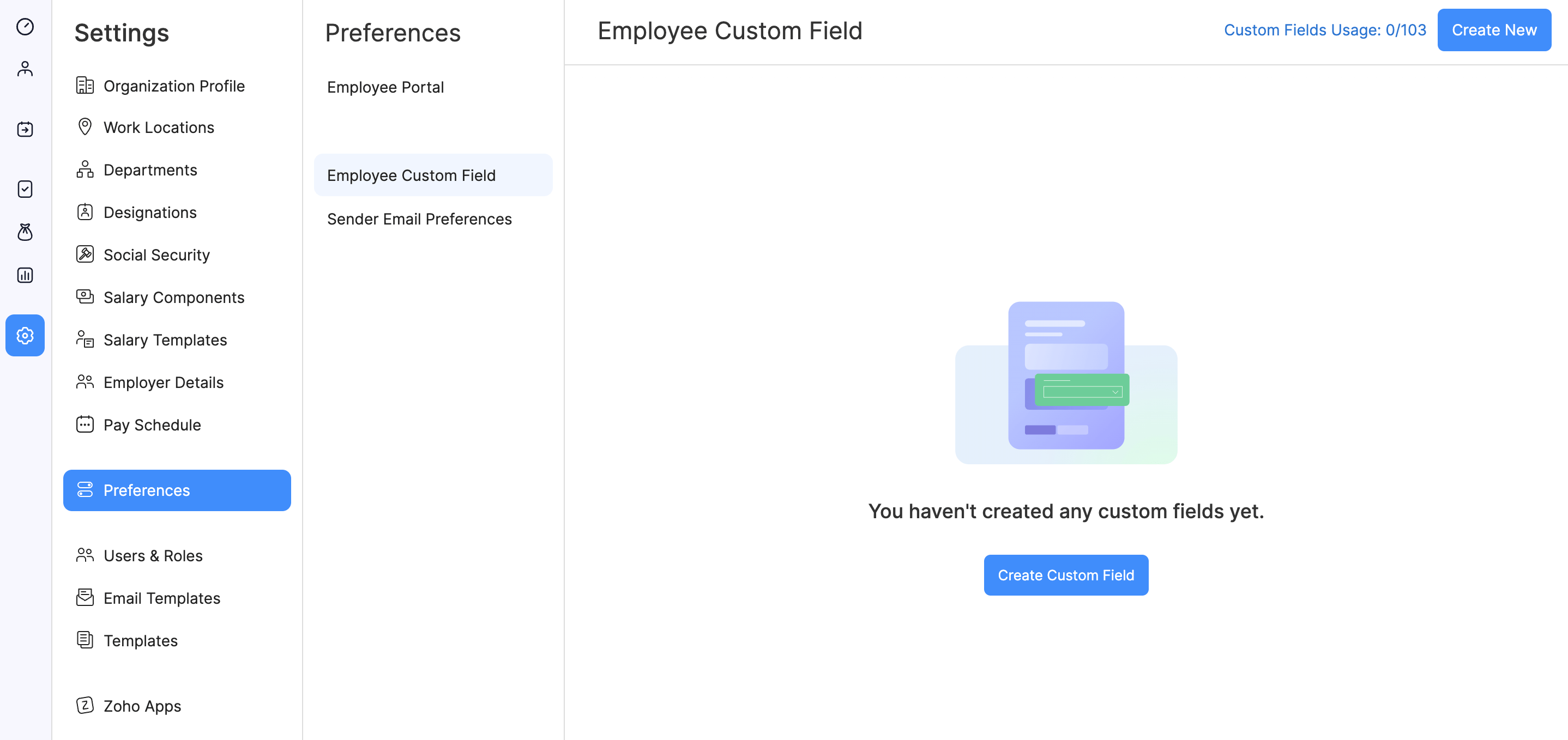
- Click Create Custom Field.
- Enter the Field Name and select the Data Type from the dropdown menu.
- Based on the data type, you will have to fill out the necessary information that will help with filling out the details. Given below are the data types available in Zoho Payroll:
| Data Type | Information Needed |
|---|---|
| Text Box (Single Line) | * Help Text * Is this PII? * Default Value |
| Text Box (Multi-line) | Help Text |
| * Help Text * Is this PII? * Default Value | |
| URL | * Help Text * Is this PII? * Default Value |
| Phone | * Help Text * Is this PII? * Default Value |
| Number | * Help Text * Is this PII? * Default Value |
| Decimal | * Help Text * Default Value |
| Amount | * Help Text * Default Value |
| Percent | * Help Text * Default Value |
| Date | * Help Text * Is this PII? * Default Value |
| Check-box | * Help Text * Default Value (☐ Ticked by default) |
| Auto generate number | * Help Text * Prefix * Suffix * Starting Number |
| Drop-down | * Help Text * Options * Default Value |
| Multi select | * Help Text * Options * Default Value |
| Notes | * Help * Content |
- Select PII or ePHI based on the information that the user will be entering in this field.
If the information that the user will enter in the custom field is confidential and can be used to identify a person, you can select the PII (Personally Identifiable Information) option to protect the privacy of the users’ data. PII can include phone number, email address, IP address, social security number, etc. You can choose to encrypt and store it if the data is sensitive or store it without encryption if the data is non-sensitive. If the user will enter medical information that can be used to identify a person, select ePHI (Electronic Protected Health Information) and PII. For example, an electronic copy of medical report will be ePHI. You can mark only fields such as Text, Email, URL, Phone, and Date as ePHI. The data will be considered as sensitive so it will be encrypted and stored.
- Check the option to make the field mandatory.
- Check the option to show the field in the Employee Portal.
- Click Save. Now, the field will be available in every employee’s profile.
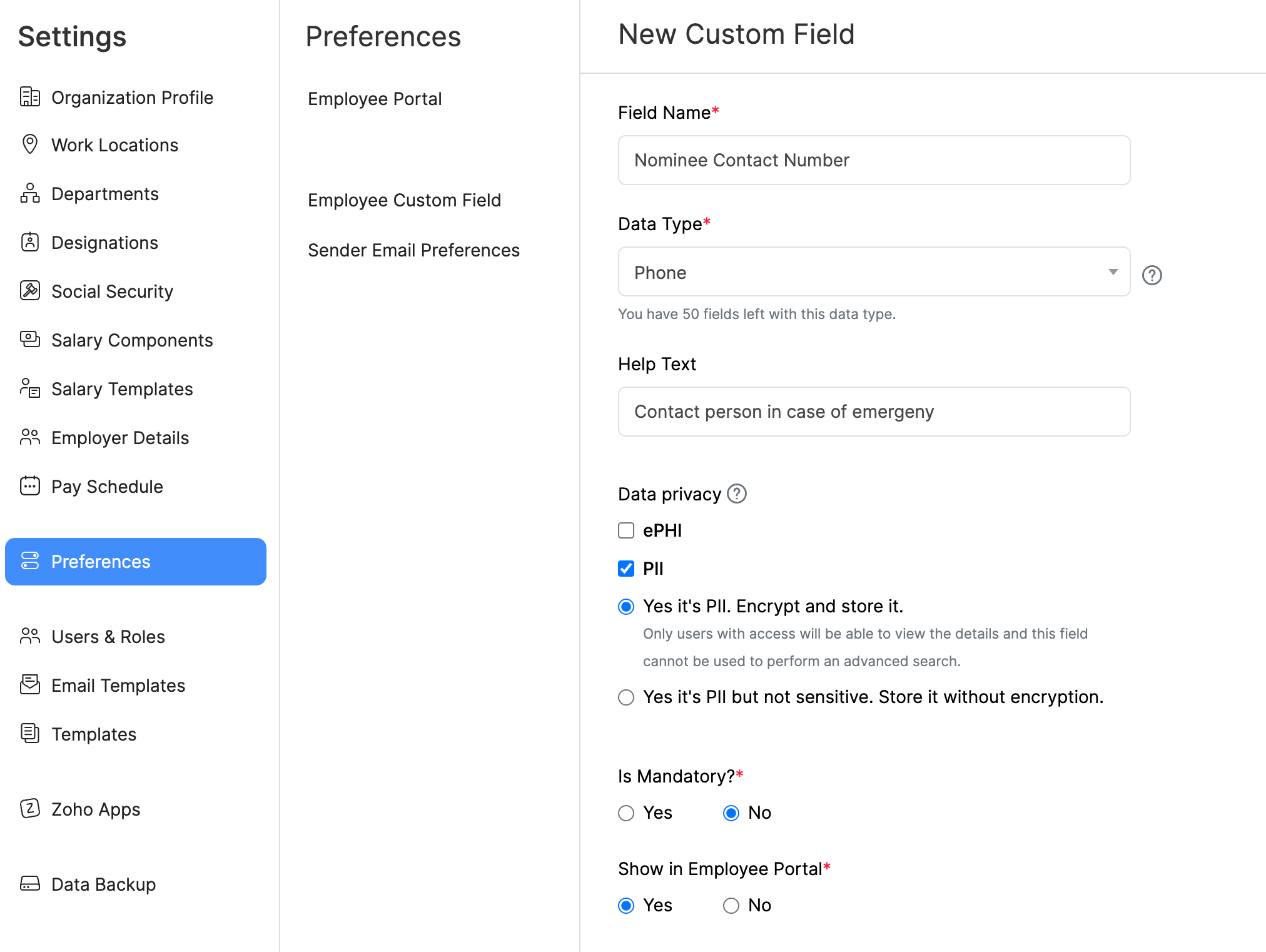
Edit a Custom Field
To edit the custom field:
- Go to Settings > Preferences > Employee Custom Field.
- Click the More icon next to the field name and select Edit.
- Make the necessary changes and click Save.

Make a Custom Field as Inactive
To temporarily mark a custom field as inactive:
- Go to Settings > Preferences > Employee Custom Field.
- Click the More icon next to the field name and select Mark as Inactive.

To enable it again, click the More icon and select Mark as Active.
Delete a Custom Field
You can delete a custom field if there is no employee data associated with that custom field. To delete a custom field:
- Go to Settings > Preferences > Employee Custom Field.
- Click the More icon next to the field name and select Delete.
- In the pop-up that opens, select Yes to confirm.

The custom field will be deleted.
Sender Email Preferences
You can configure the email addresses that are used in the From field of emails sent from Zoho Payroll. However, these emails can sometimes land in your recipient’s spam folder, causing them to go unnoticed. This happens when the email address in the From field of an email belongs to a domain that does not have SPF and DKIM records.
What are SPF and DKIM records?
By adding an SPF (Sender Policy Framework) record to your domain, your recipient’s mail server will be able to verify that Zoho Payroll is sending emails using your email address with your domain’s permission. Without the SPF record, the emails that Zoho Payroll sends on behalf of your domain will mostly end up in your recipient’s spam folder.
DKIM (Domain Keys Identified Mail) is also used for preventing spam and allows the recipient email server to verify whether an email was sent and authorized by the owner of that domain.
DKIM and SPF records are effective in preventing spam when used together. For this reason, Zoho Payroll will consider a domain as authenticated, only if it has both SPF and DKIM records.
Domain Classification
Zoho Payroll has classified domains into 3 categories to help you identify the email addresses, which if used in the From field of emails, could cause emails to go to the spam folder.
To find out which category your email addresses belong to, go to Settings > Preferences > Sender Email Preferences.
The 3 categories that you will find in this page are:
1. Unauthenticated Domains
Email addresses that belong to a domain without SPF and DKIM records will be listed here. If any of these email addresses are selected in the From field of an email sent from Zoho Payroll, the email address in the From field will be replaced automatically with message-service@sender.zohopayroll.com, which is Zoho Payroll’s own email address. This is done to prevent the email you send from landing in the Spam folder.
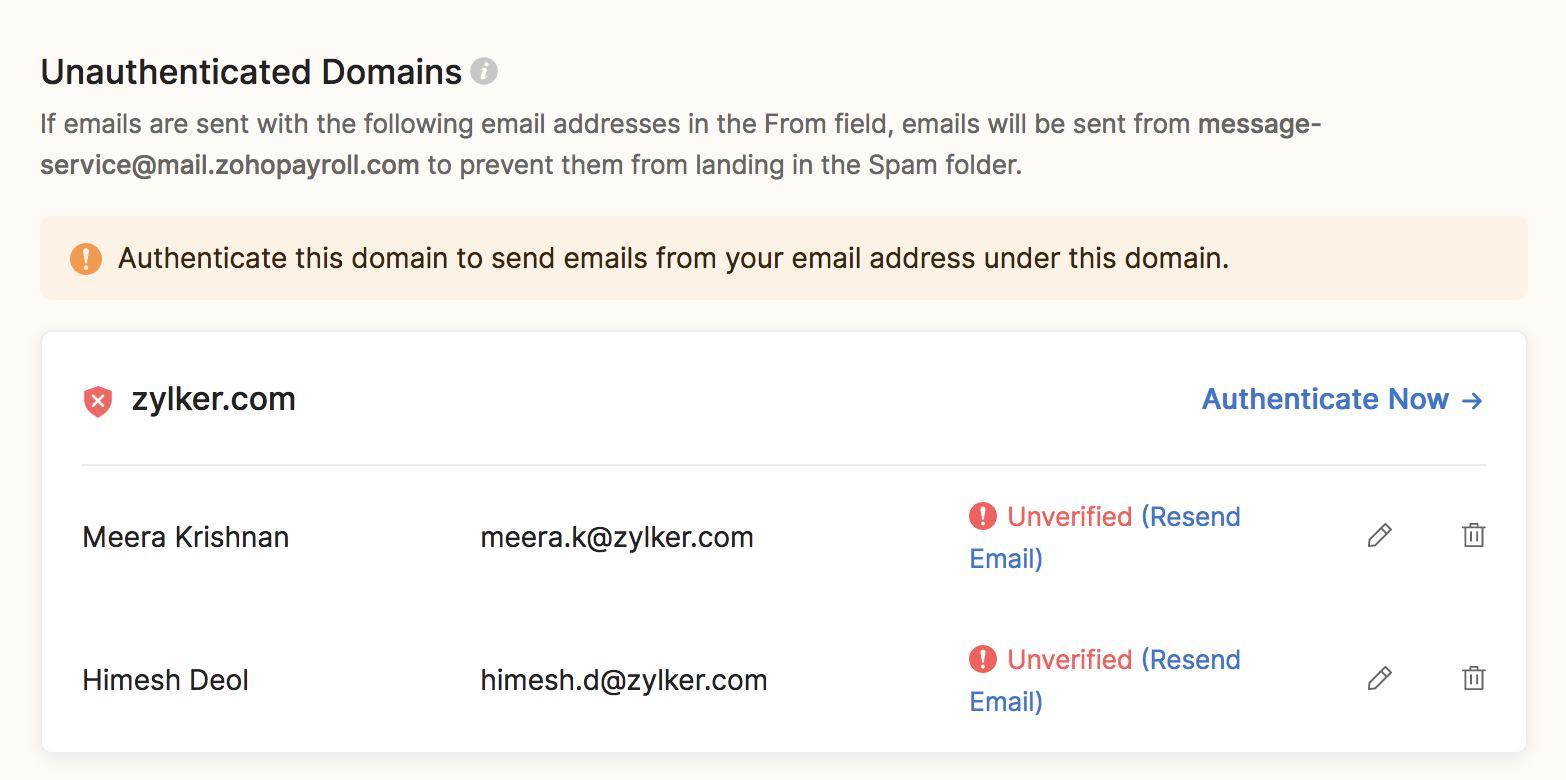
It’s important to note that the message-service@sender.zohopayroll.com address will only be used in the From address for emails and not the Reply-To address. i.e, your customers will still be able to see your name in their inbox and when they reply, their email will be delivered to your own email inbox.
To use the email addresses under this category in the From field, you must authenticate their domains.
2. Authenticated Domains
Email addresses that belong to a domain with both SPF and DKIM records will be listed here. These email addresses can be used in the From field of emails sent from Zoho Payroll without having to worry about them ending up as spam.

3. Public Domains
If you use an email address that belongs to a public domain, such as Gmail or Yahoo Mail in the From address of emails sent from Zoho payroll, it will be replaced with message-service@sender.zohopayroll.com. This is because SPF and DKIM records cannot be added for public domains and can only be added for domains that you own.
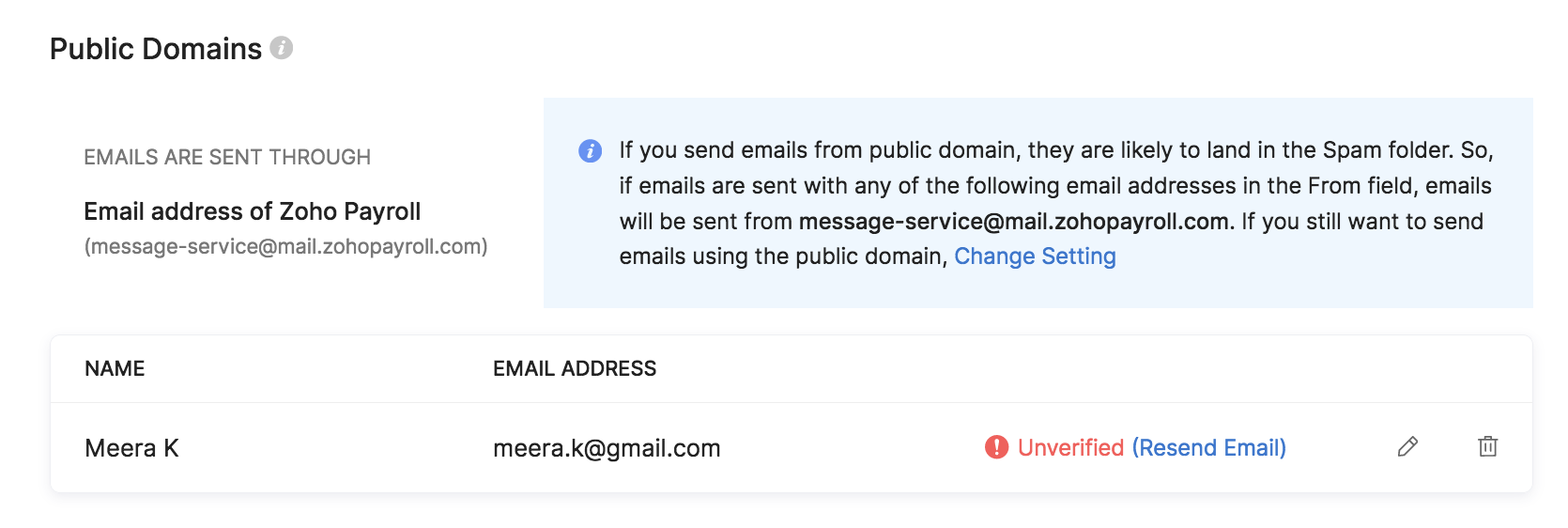
If you still wish to use emails listed in this category in the From address, you can do so by clicking Change Setting. Next, select Sender’s email address in the pop-up that follows and click Save.
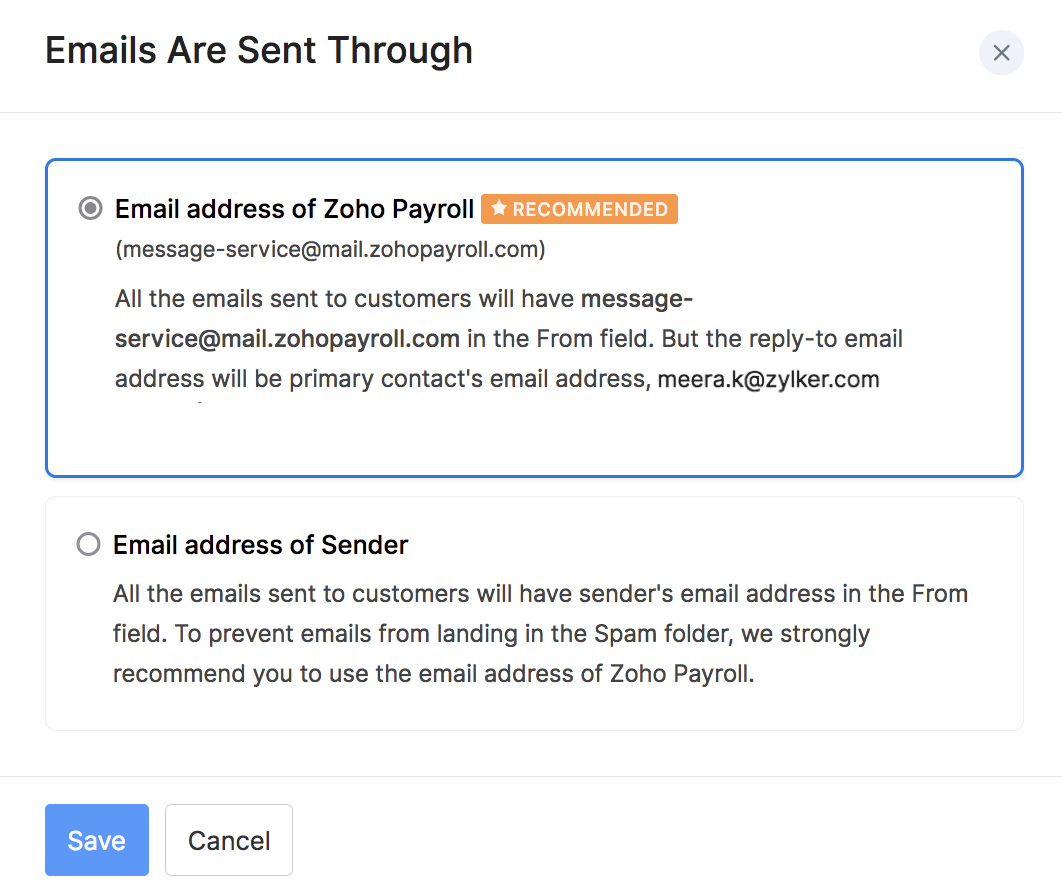
Now, email addresses from public domains will not be replaced with message-service@sender.zohopayroll.com.
Warning: We strongly recommend that you use message-service@sender.zohopayroll.com instead of email addresses from a public domain to prevent your emails from ending up in the Spam folder.
Authenticate Domains
Emails listed under the Unauthenticated Domains section can be authenticated by adding SPF and DKIM records for their domains.
To do this:
- Go to Settings > Preferences > Sender Email Preferences.
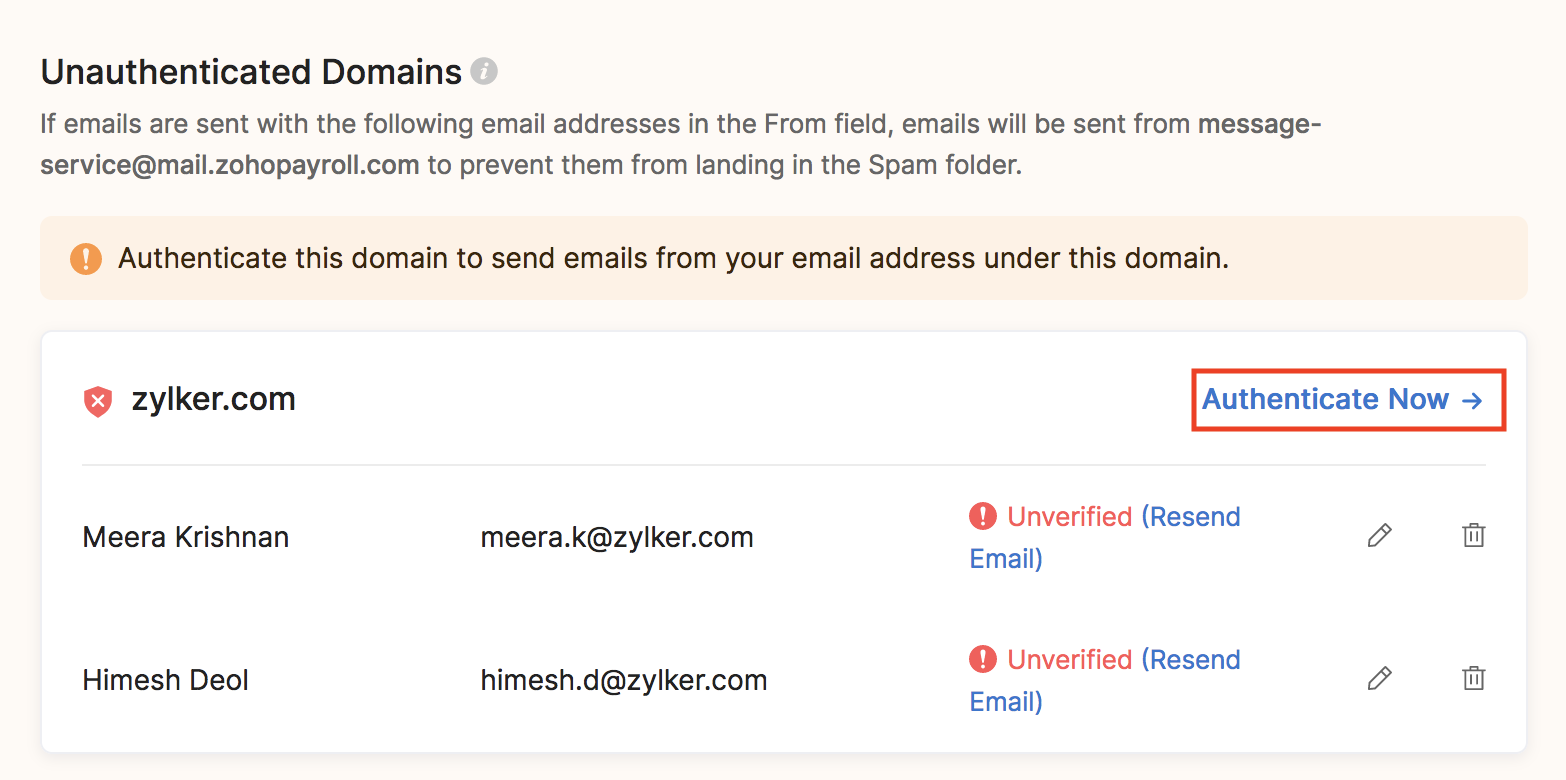
- Click Authenticate Now → next to the domain that you want to authenticate.
Now, copy the SPF record from the pop-up that follows, and add it to your domain name provider’s (e.g. Daddy) DNS settings.
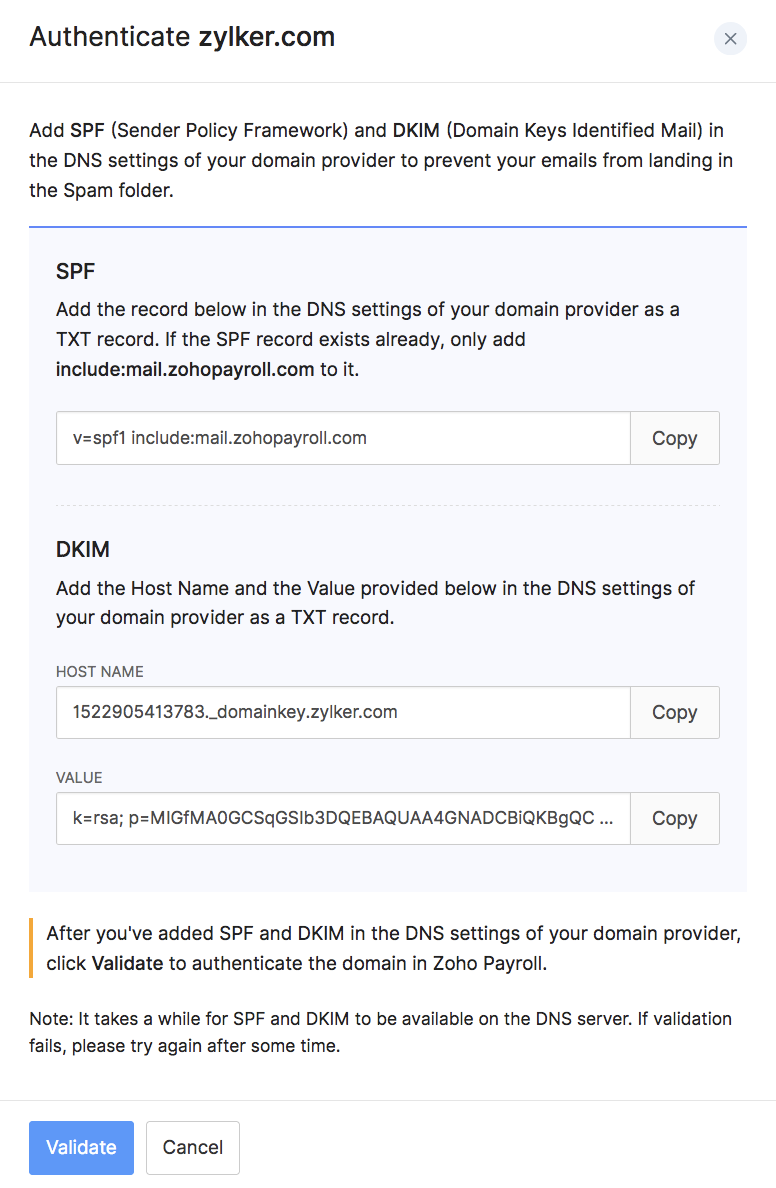
Next, copy the Host Name and Value for the DKIM record and add it to the DNS settings of your domain name provider.
Once you’ve added both the SPF and DKIM records, click Validate.
Insight: It will take a while for your newly added records to reflect on the DNS server. If your validation fails, wait for a while and try again. Also, you can continue to use Zoho Payroll while the records are being validated.
A few points to note about adding SPF and DKIM records:
- If an SPF record already exists for your domain, i.e, you’ve added an SPF record for a different service in the past, you must remove v=spf1 from the SPF record before adding it to your domain.
- If you use GoDaddy as your domain name provider, the Host Name for the DKIM record will have to be slightly modified. You will have to remove your domain name alone from the record, before adding it. For example, if the Host Name is 1522406527365._domainkey.patricia.com, you will have to remove your domain name from it and add 1522406527365._domainkey alone.
Now, your domain has been authenticated and it will be listed under the Authenticated Domains category. The emails from this domain can be used in the From address, without having it replaced or worrying about it landing in spam.
Other Actions
You can perform a few other actions from the Sender Email Preferences page.
Mark Primary Contacts
A primary contact is an email address that will be used as the point of contact between your Zoho Payroll’s organisation and Zoho. Updates regarding your Zoho Payroll’s organisation, such as subscription renewals and usage related emails will be sent to this email address.
Also, this email address will be used as default in the From address of emails sent from Zoho Payroll, unless you change it manually while sending an email.
To mark a contact as primary, hover over an email address and click Mark as Primary Contact.

Add New Sender Email Addresses
You will be able to add new sender email addresses and select them when you send emails from Zoho Payroll. To do this:
- Go to Settings > Preferences > Sender Email Preferences.
- Click Add Sender on the top right.

- Add a Name and Email Address.
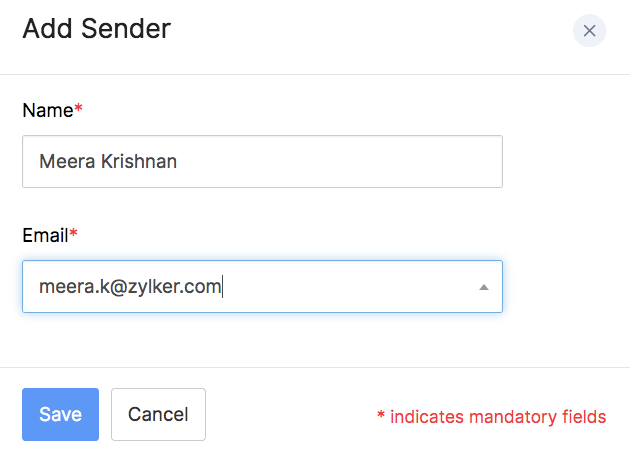
- Click Save.
Now, a verification email will be sent to the email address that you added. Once the email address has been verified, you will be able to use it in the From field of emails sent from Zoho Payroll.
Insight: Adding an email address this way will only enable the email address to be used for sending emails from Zoho Payroll and is not to be confused with adding users to your organisation.
Resend Verification Emails
As mentioned in the previous section, when you add a new sender email address, a verification email will be sent to that email address. However, if the email was not received, you can resend the verification email. Here’s how:
- Go to Settings > Preferences > Sender Email Preferences.

- Click Resend Email next to an email address that has not been verified yet.
The verification email will be sent again.
Edit/Delete Email Addresses
You can choose to edit or delete your users’ email addresses from Zoho Payroll by clicking the Pencil or Trash icon, respectively, which can be found on the right side of an email address.

Once you delete an email address,it will be removed from the organisation and emails will no longer be sent from that address. However, you can add it again, if necessary.
